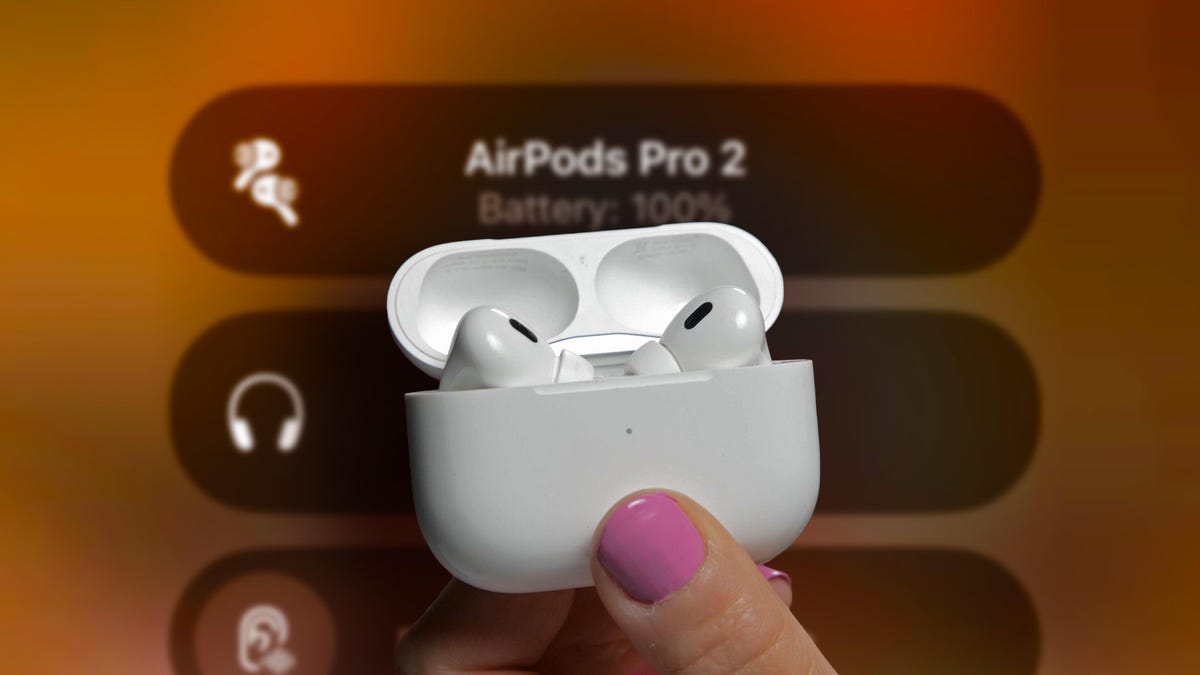Apple’s AirPods Pro 2 are still some of the best wireless earbuds out there, even a year and a half after their release. This is because Apple added many new features in iOS 17, such as adaptive audio, conversation awareness, and custom volume. We may see even more AirPods Pro 2 features announced at Apple’s Worldwide Developers Conference on June 10.
In the meantime, there are plenty of lesser-known AirPods Pro 2 features you can try out right now. I’ve been using the AirPods Pro 2 since their release, both the original model and the “new” version with USB-C charging that arrived alongside the iPhone 15.
The best part? Some of these tips will work with older versions of AirPods and even AirPods Max headphones. Just make sure you have updated to the latest version of iOS 17.

Hidden Control Center Options
Control Center is a quick way to access many AirPods settings. With your AirPods connected to your iPhone, press and hold the volume slider and a list of options will appear below, such as noise control mode, conversation awareness, and spatial audio toggle.
But there’s even more you can add to Control Center in just two easy steps. First, add the Audience option by going to Settings > Control Center. Then he returns to Settings > Accessibility > Hearing Control Center and taps the green plus icon next to any or all of the options, such as Background Sounds and Live Listening. Background Sounds plays rain, ocean, and other sounds as white noise in your headphones to help you focus. You can learn more about the Listen Live feature below.
Now, swipe down to open Control Center again and you should see the Hearing icon that looks like an ear. You will be able to see the battery charge of your AirPods and control all the options you activated in the previous step, such as Live Listen.
Listen live
Live Listen allows you to amplify what your iPhone’s microphone picks up and transmit it directly to your ears with any AirPods model. It’s primarily an accessibility feature, but you could use it to hear what’s going on in a nearby room—say, for example, as an audio-only baby monitor.
This function is also found within the Hearing option within the Control Center. Once you’ve turned it on, scroll down and tap the Hearing icon in Control Center, then Live Listen.
Customize audio with headphone adaptations
Do you want to change the default sound profile on your AirPods? If you use Apple Music, you can start by adjusting the equalizer by going to Settings > Music > EQ. Other streaming apps like Spotify have their equalizer tool that you can customize to your liking.
Apple’s headphone fitting options also let you fine-tune your audio further. Gonna Settings > Accessibility > Audio/Visual > Headphone Accommodations. Now you can choose between balanced tone, voice, or brightness, or boost soft sounds with the slider tool.
You can also add custom audio settings within the Headphone Adaptations menu. Tap the custom audio option, then your AirPods will switch to noise cancellation mode and you will be asked if you can hear the words quietly. It will play two audio samples and you will choose which one you prefer.
Custom spatial audio
Your iPhone’s TrueDepth camera does more than just FaceID. You can use it to get personalized spatial audio tailored to the shape of your ears.
Gonna Settings > AirPods > Custom Spatial Audio and then follow the instructions to set it up. You will be asked to hold the phone in front of your face and then turn your head left and right to map your ears. Now, make sure spatial audio is turned on from the Control Center and test it with supported movies and music.
Share audio with a friend
Do you remember the old days of sharing music with a friend with wired headphones? Here’s the 2024 version. Swipe down to open Control Center, then tap the AirPods icon in the top right corner inside the music playback box. Tap Share Audio.
Bring another pair of AirPods or Beats closer, open the lid, and then press and hold the pairing button on the case. Follow the on-screen instructions to connect this other pair to your phone and you’ll be able to play the same songs.
Siri can describe images received in Messages
I recently discovered that Siri can describe received photos in the Messages app when I’m using AirPods Pro 2 and my phone is locked. For example, one day I was waiting for a bus and Siri announced that my best friend had sent me a photo of a brown dog lying on a black and white checkered floor. I pulled out my phone to check it out and Siri was spot on.
I haven’t found the magic trick that makes Siri do this with every photo, but so far it has worked on images of people and pets that are centered in the frame with a light background. I’ve contacted Apple for more information about this feature and will update this story with more details.
To try to replicate this yourself, make sure “announce notifications” is turned on by going to Settings > Notifications > Announce notifications, and that the Headphones option is also activated. Scroll down this page to make sure the Messages app is turned on. Now, ask a friend to send you a photo (SMS and iMessage have worked for me) to see if it works.
Unlock more AirPods settings with the Shortcuts app
The iPhone Shortcuts app is a powerful tool to get even more out of your AirPods. One of my favorite shortcuts is to have the AirPods automatically switch to my favorite setting every time they connect to my iPhone: noise cancellation mode at 40% volume.
First, make sure your AirPods are in your ears and connected to your iPhone. Open the Shortcuts app > Plus icon > Add action. Here you’ll want to search for “set noise control mode” and then tap the gray box that says “path.” Select the name of your AirPods in this menu, then choose their mode (in this example, noise cancellation).
Next, you’ll want to add another action. In the “Search apps and actions” bar, type “Set volume” and select it. Now, change the volume to 40% (or whatever volume you want). Give your shortcut a fancy name and tap Made.
Now let’s make this shortcut run automatically when you put the AirPods in your ears. Go to the Automation tab, tap New Automation, and search for Bluetooth. Where it says the device, find the name of your AirPods, make sure “is connected” is turned on, and then “run immediately.” Press Next and then choose the shortcut you just created. The next time you put the AirPods in your ears and connect them to your phone, this shortcut should launch and you can try it out.
Keynote USA News
Besides Apple News, You can get Airpods | Apple TV | Vision | Mac | iPhone | iPods News. So, Follow @Keynote USA News on Twitter and Google News




